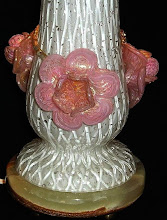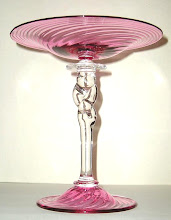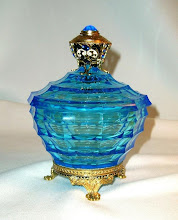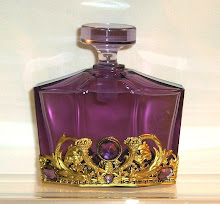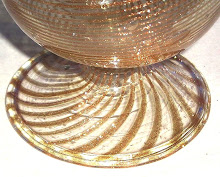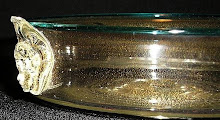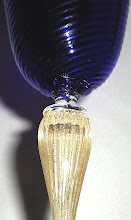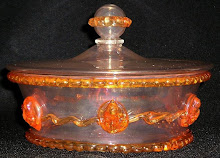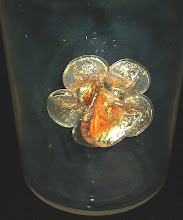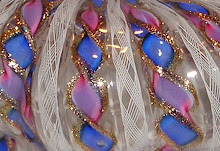Most photos down the right column as well as those within our posts can be enlarged simply by clicking on the individual images. Those in the right column are linked to the full descriptions of the items, as well as detailed closeup photos. We hope you enjoy them!
NOTE: For more information on the items appearing in our SLIDE SHOW (just beneath the "chocolate sherbet") in the right-hand column, please contact us. Clicking on those photos will only take you to a blank page.
Thursday, January 29, 2009
Wednesday, January 21, 2009
Rare Venetian Ice Glass Vase from 19th Century Baroviers

A rare surviving piece of genuine Venetian "Ice Glass," attributed to the Barovier Furnaces of the 1890s. This magnificent spherical ice glass vase was once a lamp; the abusive hole which accommodated the lamp rod has been superbly restored by a now deceased master craftsman. The repair is so well done that it is only detectable after one has been told of it. Both the beauty and the attributed parallel history of the piece are worthy of inclusion in a museum collection.
For a bit of history, we turn to Sheldon Barr's Book on Venetian Glass...in 1895,
 five years after the death of Salviati and his assigning the Salviati furnaces to the Baroviers, several rejuvenating elements "...added new dimension to the production of the Barovier Family." One of those new elements was the "...introduction of a new color to the glassmaker's repertoire, a bright blood red...." It was the same blood red of this rare and striking ice glass vase.
five years after the death of Salviati and his assigning the Salviati furnaces to the Baroviers, several rejuvenating elements "...added new dimension to the production of the Barovier Family." One of those new elements was the "...introduction of a new color to the glassmaker's repertoire, a bright blood red...." It was the same blood red of this rare and striking ice glass vase.The method of creating ice glass was first developed in Venice in the mid-16th Century. 
In an effort to give their prized "cristallo" [see "Glass Terms According to Barclay" at the very end of our blog] the Venetian glassmakers tirelessly experimented with new methods, eventually inventing "ice glass." A new, hot gather of glass, after a brief initial shaping, would be plunged momentarily into cold water. It was then gently reheated and the the final blowing resumed, causing all of the tiny cracks in the glass to spread, weblike, and enlarge, creating the crackled, glistening appearance of frosty ice. Our sparkling Ice Glass example is circa 1895-1900.
Friday, January 16, 2009
18th Century German "Forest-Green" Roemer
Following is our opinion recently given to a customer regarding art glass goblets which have been passed down through her family. The customer believed them to be Venetian, so we have touched upon that in our opinion, even though we are reasonably certain the goblets are German in origin. [click on photos to enlarge.]
"Thank you for sharing your most interesting Goblet with Barclay Galleries.
The goblets could be anywhere from the 17th Century (1600s) to the early 19th Century (1800s). However, I suggest that they are most likely early 18th Century (1700s); and of German origin. There is a possibility they were created in England, but my strongest sense is that they are German with many characteristics to substantiate that opinion.
Glasshouses in 17th Century Germany produced their "forest-green" Roemers (German drinking vessel for white wine -- the mainstay wine of Germany) in enormous quantities -- hundreds and hundreds of thousands. They became popular throughout Europe, but primarily of course, in Germany and Holland. The style was inspired not only for the white wine, but in imitation of the styles created by the Venetian glassmakers; hence they were created in "facon de Venise," or translated, "in the style of Venice." "Facon de Venise" (or "the Venetian style") spread throughout Europe, and then much later, even to the U.S., in the 19th Century.
Roemers of late 17th, early 18th Centuries had distinct characteristics, much like those in your goblet. They consisted of a Foot made of a glass thread which was spun around a wooden form, and a hollow shaft which extended to the roundish or ovoid bowl. I cannot tell from the photo if your shaft is hollow, but if it is, then the suggested date of origin is probably correct. If it is closed at the base of the bowl, then the goblets are likely not as old as I have suggested, and would be more into the early-to-mid 19th Century.
 The shaft was decorated with "raspberry prunts" (blobs of glass which were impressed with a clay form to make the "raspberries"). In addition to this prunt being decorative, it was originally designed for providing the drinker with a better grip, as forks in the 17th Century were not commonly in use, and hands at the dining table (or pub) were usually greasy. These early German designs also displayed the ribbed glass thread visually separating the bowl from the shaft, as in your goblet. It appears in the photo, almost as if a row of glass beading above the prunts.
The shaft was decorated with "raspberry prunts" (blobs of glass which were impressed with a clay form to make the "raspberries"). In addition to this prunt being decorative, it was originally designed for providing the drinker with a better grip, as forks in the 17th Century were not commonly in use, and hands at the dining table (or pub) were usually greasy. These early German designs also displayed the ribbed glass thread visually separating the bowl from the shaft, as in your goblet. It appears in the photo, almost as if a row of glass beading above the prunts.These goblets, were the most popular type of the "forest-green" drinking vessels, and the most well known of those vessels, during the 17th Century. By the 18th Century, they were declining in popularity.
Roemers in this day are no longer popular for use, but there will always be collectors of antique glass who will find them of interest for their collections.
It's been a pleasure -- and I hope this is helpful to you, and that you continue to enjoy your lovely goblets. They are a fine treasure."
It's been a pleasure -- and I hope this is helpful to you, and that you continue to enjoy your lovely goblets. They are a fine treasure."
Subscribe to:
Posts (Atom)

